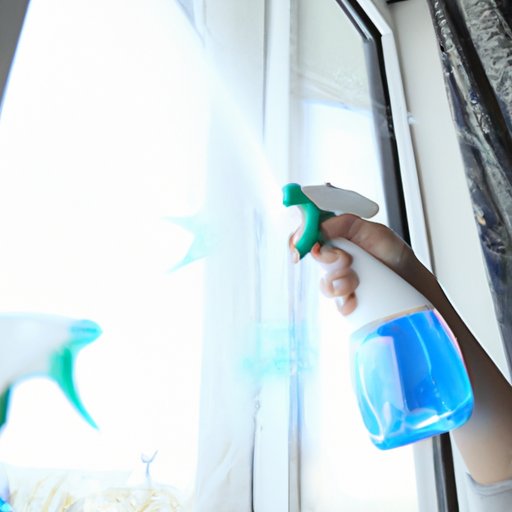Introduction
Windex is a popular cleaning product that is often used to clean windows and other surfaces. But can you use Windex on a TV? It’s important to understand the potential risks before attempting to clean your television with Windex or any other cleaning product.
What is Windex?
Windex is a glass cleaner that has been around since 1933. It’s a commercial product made up of a mixture of ammonia and surfactants, which are molecules that reduce surface tension and allow for easier cleaning. It’s commonly used to clean windows, mirrors, and other nonporous surfaces.
Why Would You Want to Clean Your TV with Windex?
Like other electronics, televisions can attract dust and dirt over time. This can make the screen appear hazy and dull, reducing the picture quality. Regularly cleaning your TV can help keep it looking its best, and Windex is often chosen as a cleaning solution because it’s easy to find and relatively inexpensive.
A Guide to Cleaning Your TV with Windex
If you decide to use Windex to clean your TV, there are some steps you’ll need to take in order to do it safely. Here’s what you’ll need:
- Windex
- Soft cloth
- Microfiber cloth
- Vacuum cleaner (optional)
Now that you have the supplies, here’s how to clean your TV with Windex:
- Turn off the power to the TV.
- Use the vacuum cleaner to remove any dust or debris from the surface of the TV.
- Spray Windex onto the soft cloth, not directly onto the TV.
- Gently wipe the TV in circular motions, starting at the top and working your way down.
- Once you’ve finished wiping the TV, use the microfiber cloth to buff the surface and remove any remaining streaks.
- Turn the power back on and enjoy a squeaky-clean TV!
Is Windex Safe to Use on TVs?
It’s important to understand the components of your TV before deciding whether or not to use Windex. Televisions come in many different types, from plasma and LCD to LED and OLED. Each type of TV has different components that must be taken into consideration. For example, LCD and LED TVs have a thin plastic film that covers the display, while plasma TVs have a glass panel.
Using Windex on any of these components could potentially damage them. Windex is an ammonia-based cleaner, and ammonia can cause discoloration or etching on certain types of screens. It can also damage the thin plastic film on LCD and LED TVs. Additionally, Windex should never be sprayed directly onto the TV, as it can seep into the device and cause further damage.

The Pros and Cons of Using Windex on a TV
Now that you know the potential risks of using Windex on your TV, let’s take a look at the pros and cons.
Advantages
- Windex is easy to find and relatively inexpensive.
- It can help remove dust, dirt, and fingerprints from the surface of the TV.
- It can be used to clean other electronics, such as computer monitors.
Disadvantages
- It can potentially damage certain types of TVs.
- It can leave behind streaks if not wiped properly.
- It’s not suitable for all types of TVs.

How to Avoid Damaging Your TV When Using Windex
If you decide to use Windex to clean your TV, there are some precautions you should take to avoid damaging it. First, make sure you’re using the right type of Windex for your TV. Second, never spray Windex directly onto the TV; always spray it onto a cloth first. Third, be gentle when wiping the TV, and use a microfiber cloth to buff out any remaining streaks.
Finally, be sure to read the instructions on the Windex packaging before using it on your TV. Different types of TVs may require different cleaning methods, so it’s important to understand what type of TV you have and what cleaning products are safe to use on it.
Different Cleaning Alternatives
If you’d rather not use Windex on your TV, there are a few alternatives you can use. One option is to use a mild soap and water solution, then buff the surface with a microfiber cloth. Another option is to use a dedicated LCD/LED TV cleaner, which is specifically designed for cleaning LCD and LED TVs. Finally, you can purchase a special cleaning kit for your TV, which usually comes with a cleaning solution and cloth.

What You Need to Know Before Cleaning Your TV with Windex
Cleaning your TV with Windex can be a great way to keep it looking its best, but it’s important to understand the potential risks first. Different types of TVs have different components, and Windex can damage some of them if used improperly. Be sure to read the instructions on the Windex packaging before using it, and take appropriate precautions to avoid damaging your TV.
Conclusion
Windex is a popular cleaning product, but it’s important to understand the potential risks before using it on your TV. Different types of TVs have different components, and Windex can damage some of them if used improperly. If you decide to use Windex, be sure to take appropriate precautions and follow the instructions on the packaging. There are also a number of alternative cleaning methods you can use if you’d rather not use Windex.
In the end, it’s up to you to decide whether or not to use Windex on your TV. Just remember to be informed and take the necessary precautions to avoid damaging your TV.


